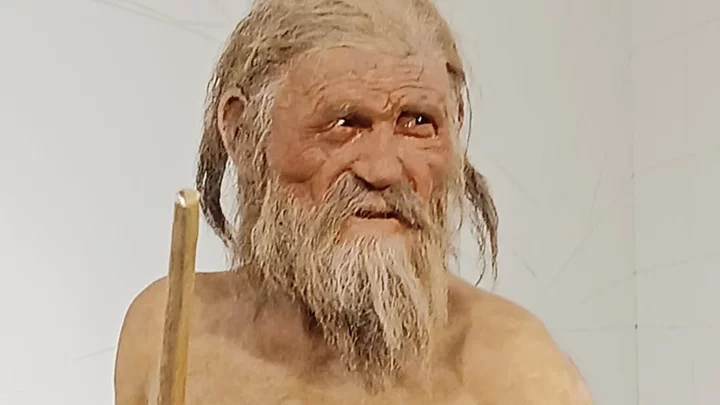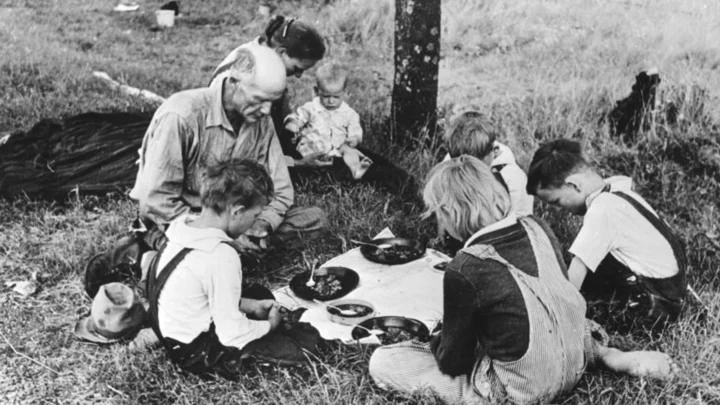When hikers in the Ötztal Alps stumbled on a body melting out of a glacier in September 1991, they thought they had found an unfortunate mountaineer who had disappeared perhaps a couple decades prior. But as soon as it was revealed that the mummified remains dated back 5300 years—and that the man had been murdered by an arrow to the back—researchers knew they had to solve the most fascinating ancient forensic case ever found. Nicknamed Ötzi, the Iceman, and Frozen Fritz, the body of a man who was around 40 or 50 years old when he died in the Copper Age continues to generate new data about a past era and shows links to contemporary people. Here are 13 surprising facts about Ötzi.
1. Two countries fought over ownership of Ötzi.
Ötzi might very well be the oldest person ever subject to a custody dispute. He was discovered in a part of the Alps mountain range that is right on the border between Austria and Italy. Complicating the find is the fact that the glacier in which he was entombed for millennia has shrunk since the official country border was established in 1919. This means that, although the find site of the mummy drains into Austria, the place Ötzi was actually resting is about 100 meters into Italian territory. Originally, Ötzi was studied at Innsbruck University in Austria, but since 1998 he has been displayed and studied at the South Tyrol Museum of Archaeology in Bolzano, Italy.
2. Ötzi’s death may have been recorded in stone.
In 1991, an upright, carved stone was found in the town of Laces, near the Ötztal Alps where the Iceman was discovered. Although the stone was reused in modern times for the altar of a church, it dates to the Copper Age, just like Ötzi. One of the carvings on it depicts an archer shooting an arrow into the back of an unarmed man—which bears striking similarities to how scientists know Ötzi died. This circumstantial evidence, though, has not convinced most researchers.
3. Ötzi had gastrointestinal issues.
Even though Ötzi was comparatively old when he died, he was not exactly healthy. Whipworm parasite eggs were found in his gut contents, so he probably suffered from nausea, vomiting, and diarrhea. His body also produced a full genome of H. pylori, a common stomach bug responsible for ulcers and other tummy troubles. There is also evidence that he had ingested a medicinal herb called hop hornbeam shortly before his death, possibly to help his indigestion. And one fingernail was found to have Beau’s lines, which can be created when the immune system is compromised. Ötzi’s fingernail shows he was ill several times in the four months prior to death.
4. Ötzi carried a first aid kit.
Since Ötzi died while going about his daily life, the artifacts found with him give us a snapshot in time. Two particularly curious objects were spheres of botanical material about the size of walnuts that were strung on leather straps. Analysis of the masses indicated they were a fungus called Piptoporus betulinus. Notably, this fungus—if eaten—both causes diarrhea and can protect against certain mycobacteria. It is likely that Ötzi was ingesting this fungus in an attempt to treat his whipworm—the diarrheal action would have helped him get rid of the parasite’s eggs, while the antibiotic properties of the fungus would have killed off other intestinal bugs. Fungi like this were used for medicinal purposes until the 20th century.
5. Ötzi has the oldest tattoos in the world.
The mummy boasts 61 different tattoos, and they are the oldest physical evidence of tattooing in the world. While the Iceman doesn’t have “MOM” on his biceps or a butterfly on his lower back, his tattoos are still quite interesting. They were made by scratching his skin and rubbing charcoal in the fresh wound, resulting in groups of lines or crosses. It has also been suggested that their placement over joints may have been an attempt to treat pain. As the oldest tattooed person ever found, Ötzi holds a Guinness World Record.
6. Ötzi wore a variety of leathers and hides.
Long before Dolce & Gabbana dressed dapper Italian men, Ötzi was mixing materials to create his clothing. A 2016 study revealed the variety of species used to make Ötzi’s outfit. He wore a sheepskin loincloth, goat hide leggings and coat, and a hat made of the skin of a brown bear. Even his accessories were diverse: His shoelaces came from wild cows and his quiver from roe deer.
7. Ötzi’s tools demonstrated the latest technology.
Ötzi’s field kit held a surprising number of different tools. There was a copper-bladed axe, which marks him as high status; a flint dagger and its tree-fiber sheath; and a bow made out of a yew tree. His quiver, fashioned out of deer hide with hazel wood supports, contained two finished arrows and a dozen unfinished shafts. He had a net for catching rabbits and birds, as well as a marble disc with a hole in the middle for hanging or carrying dead fowls. He also carried cylindrical containers made of birch bark, which kept charcoal embers hot for hours so he could quickly make a fire. His teeth were worn particularly on the left side, meaning he may have used his mouth to help work leather. The Iceman’s hair also revealed high levels of arsenic, suggesting he was a pro at smelting ores to make copper.
8. Ötzi was a fighter.
Ötzi was short and stocky, around 5 feet 2 inches tall and 135 pounds, with strong legs. Visible injuries suggest he engaged in combat: Several right-sided rib fractures had healed, while Ötzi was struck in the head shortly before his death. A protein analysis of his brain reveals some healing, particularly in the form of blood clots—but those could have caused a stroke or embolism. The Iceman also suffered a long, deep stab wound to his right hand. Based on the stage of healing evident from the wound tissue, it occurred three to eight days before his death. And of course, the arrow lodged in his left shoulder was likely the ultimate cause of death. In short, Ötzi was a hunter and a fighter.
9. Ötzi’s stomach contents revealed his last meal.
The materials in the Iceman’s stomach revealed both his last meal and the meal before that. A 2018 study published in Current Biology tested Ötzi’s stomach contents and found traces of his final meal: dried ibex meat and fat, red deer meat, einkorn wheat, and remnants of a toxic plant. In the early 2000s, scientists conducted a DNA analysis of samples of digested food collected from his colon. Ötzi’s second-to-last meal consisted of ibex meat along with various species of cereals and dicots (a group of flowering plants). The discovery of red deer in his digestive system is especially interesting, since depictions of that animal figure prominently in archaeological finds throughout the Alps in this time period.
10. Ötzi had a gap in his smile and other unusual characteristics.
Between Ötzi’s top two teeth is a natural diastema, which is the anatomical term for a gap in the teeth. Among modern adults, about 10–20 percent have this gap. Researchers also saw in the Iceman’s mouth third molar agenesis—the anatomical term for lacking wisdom teeth. Around 35 percent of people today lack wisdom teeth. Ötzi was also missing some bones—the smallest of the ribs on either side. This lack of ribs is not unheard of, but it only affects about 5 percent of the population.
11. You might be related to Ötzi (but only if you’re male).
The Iceman’s genome was sequenced in 2012, revealing he had brown eyes and O-type blood, was lactose intolerant, and likely had Lyme disease. The mutations in Ötzi’s paternal genetic line are most commonly found in Sardinia and Corsica today, meaning those areas likely have descendants of his genetic family. Another study in 2013 tested thousands of modern men in the Alps and discovered that 19 men in the sample shared a genetic lineage with the Iceman. His maternal DNA line, however, appears to be extinct. So if you’re a guy and your ancestors go back to this roughly 620-mile band between Sardinia and the Alps, there’s a chance you could be related to Ötzi.
12. Ötzi might be cursed.
We all know that every ancient mummy is cursed, so of course the Iceman has his own story. In 2005, rumors circulated that the deaths of at least five people may have been related to a mummy’s curse. Helmut Simon, one of the two hikers who discovered the Iceman, died falling off the side of a mountain. An Alpine guide who airlifted the mummy out of the glacier died in an avalanche. A journalist who filmed the recovery of the mummy died of a brain tumor. A forensic expert who touched Ötzi with his bare hands died in a car accident en route to a conference to talk about the mummy. Even the death of the head of the research team at Innsbruck University has been attributed to Ötzi’s curse, in spite of the fact it was from multiple sclerosis. There is, of course, no evidence that these deaths are related to anything other than bad luck or coincidence.
13. Practically every inch of Ötzi has been scanned and recorded.
Ötzi has been thoroughly CT scanned over the years for analysis. In 2016, CT scans were meshed with digital photographs, 3D printed, and then painted to create three life-size Ötzi clones. The Iceman’s first two 3D prints are on display at the DNA Learning Center at Cold Spring Harbor Laboratory, in Cold Spring Harbor, New York, along with 3D printed bones from his body. The third life-size print remains at the South Tyrol Museum of Archaeology, along with the real migratory hunter-herder, whose own journey has lasted more than 50 centuries.
A version of this story ran in 2016; it has been updated for 2023.
This article was originally published on www.mentalfloss.com as 13 Cool Facts About Ötzi the Iceman.









